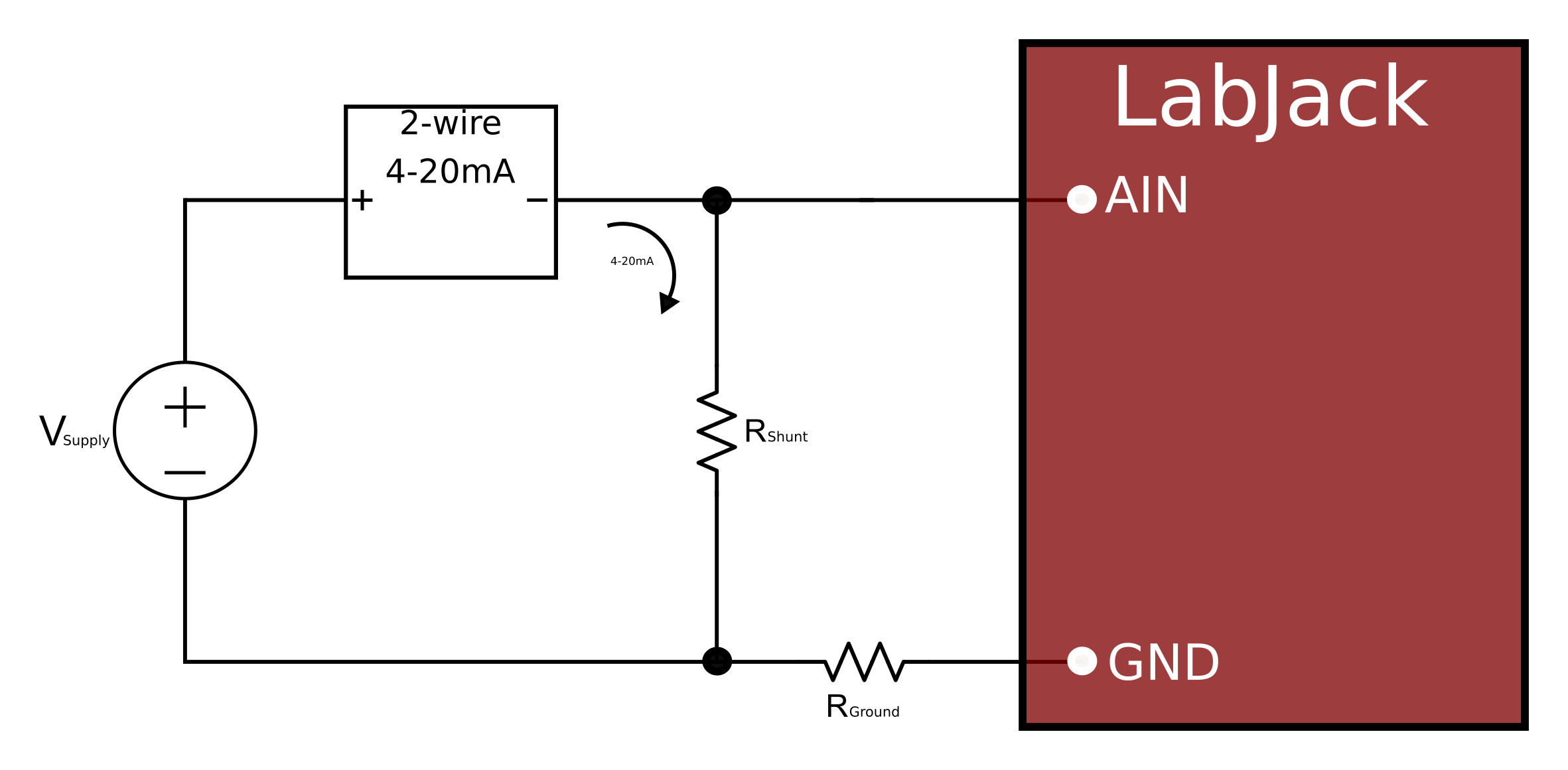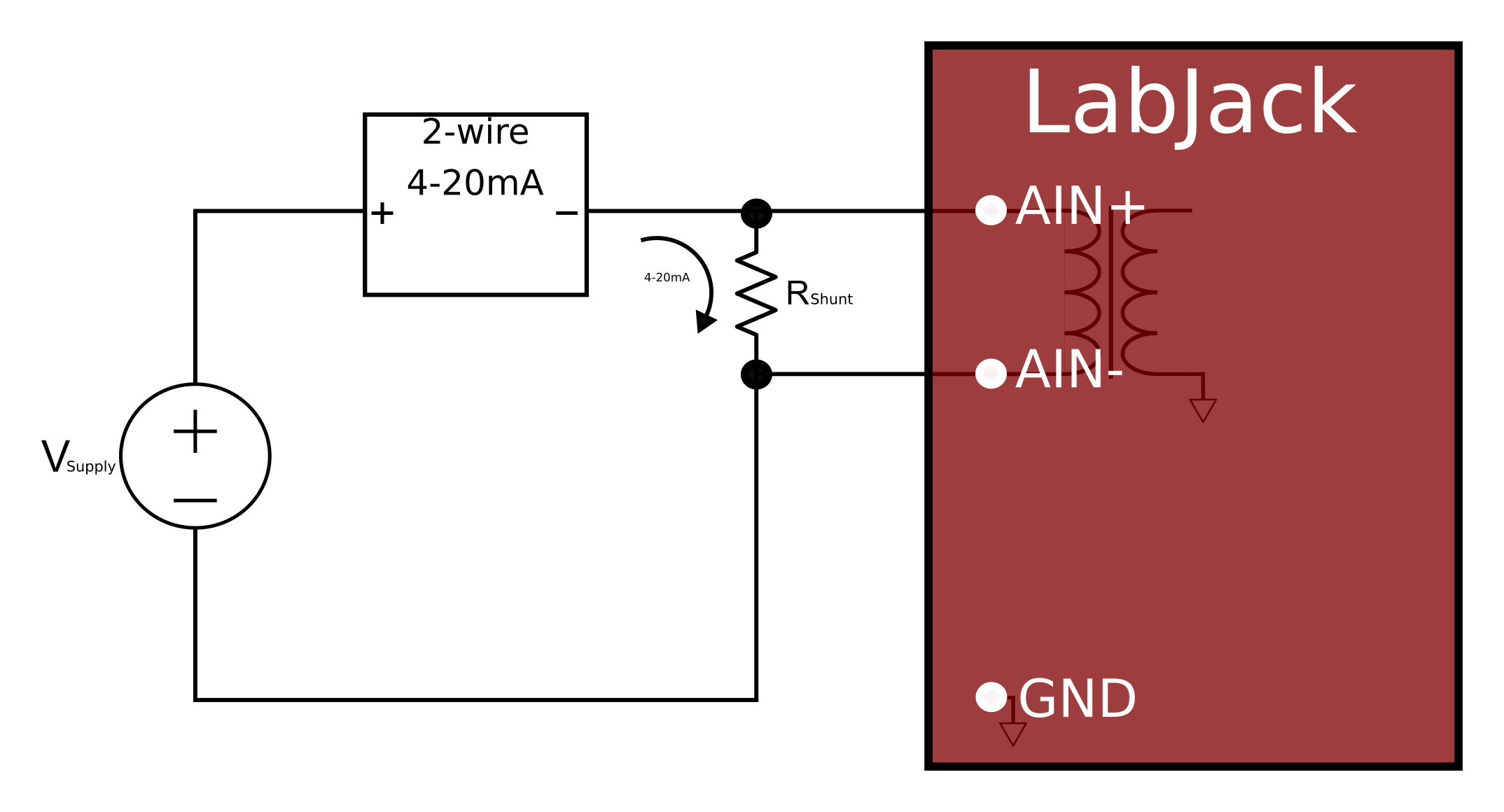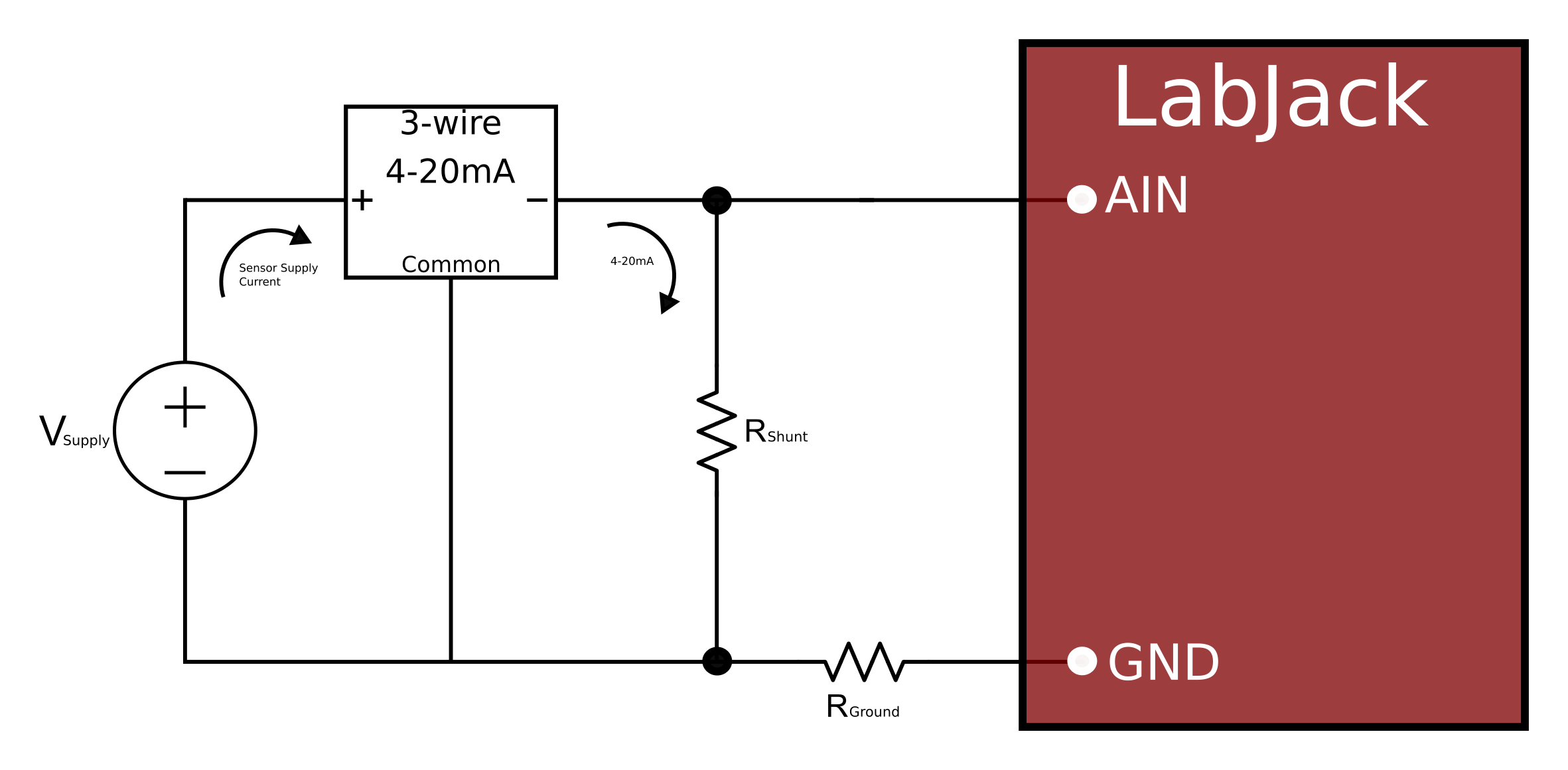Measuring Current (App Note)
Overview
LabJack analog input hardware is configured for voltage measurements. Current measurements are possible, but require conditioning circuitry between the signal and LabJack.
4-20mA Measurements
LJTick-CurrentShunt
If your LabJack does not have isolated inputs, then the best way to handle 4-20 mA signals is with the LJTick-CurrentShunt. It is a two channel active current to voltage converter module that plugs into the screw-terminals of compatible LabJack devices. LabJack devices with isolated analog inputs should always use current transducers and/or shunt resistors.
Shunt Resistor
The following figure shows a common method to measure the current through a load, or to measure the 4-20 mA signal produced by a 2-wire (loop-powered) current loop sensor.

Figure 1. Current Measurement With 2-Wire 4-20 mA (Sourcing) Sensor
If your LabJack has isolated inputs you would connect the shunt between an AINx+ and AINx- terminal as shown in Figure 2.

Figure 2. Isolated Current Measurement With 2-Wire 4-20 mA (Sourcing) Sensor
When measuring a 4-20 mA signal, a typical value for the shunt would be 240 Ω. This results in a 0.96 to 4.80 volt signal corresponding to 4-20 mA. The external supply must provide enough voltage for the sensor and the shunt, so if the sensor requires 5 volts the supply must provide at least 9.8 volts.
Figure 3 shows typical connections for a 3-wire 4-20 mA sensor. Figure 4 shows a 3-wire configuration if your LabJack has isolated inputs. A typical value for the shunt would be 240 Ω which results in 0.96 to 4.80 volts (use a 120 Ω to produce 0.48 to 2.40 volts).

Figure 3. Current Measurement With 3-Wire 4-20 mA (Sourcing) Sensor

Figure 4. Isolated Current Measurement With 3-Wire 4-20 mA (Sourcing) Sensor
The sensor shown in Figure 3 and Figure 4 is a sourcing type, where the signal sources the 4-20 mA current which is then sent through the shunt resistor and sunk into ground.
Sinking type sensors and complications (without isolated inputs)
Another rare type of 3-wire sensor is the sinking type, where the 4-20 mA current is sourced from the positive supply, sent through the shunt resistor, and then sunk into the signal wire. If sensor ground is connected to LabJack GND, which must be configured for LabJack inputs that are not isolated, the sinking type of sensor presents a couple of problems: the voltage across the shunt resistor is differential (neither side is at ground) and at least one side of the resistor has a high common mode voltage (equal to the positive sensor supply). If the sensor is isolated, a possible solution is to connect the sensor signal or positive sensor supply to LabJack GND (instead of sensor ground). This requires a good understanding of grounding and isolation in the system. The LJTick-CurrentShunt is often a better solution.
External power supply
4-20 mA sensors commonly require a supply voltage that is higher than the LabJack can provide, so an external power supply must be used. We sometimes recommend adding a small 0-100 Ω resistor between the external supply ground and LabJack GND. This is shown in Figure 1 and Figure 3 as RGround and the recommendation only applies to non-isolated inputs. See our Externally Powered Signals App Note for additional information. If SGND is used rather than GND, a direct connection (0 Ω) should work well for 4-20 mA loops.
Shunt Resistors for Other Currents
A simple shunt resistor can be used to measure smaller currents, but for larger currents the best choice is usually a Hall effect sensor or other current transducer. In some cases you may use a shunt resistor and current transducer. See the hall effect sensor and AC current sections below.
A shunt resistor is chosen based on the maximum current, the input voltage range of the analog input, power dissipation, and how much voltage drop can be tolerated across the shunt. These characteristics can be determined using Ohm's law:
Voltage = Current * Resistance → Resistance = Voltage / Current
Power = Voltage * Current
Below are some example measurement shunt selection criteria:
Max Current (A) | Max Input Voltage (V) | Ideal Shunt Resistor (Ω) | Max Power Dissipation (W) |
|---|---|---|---|
0.02 | 0.075 | 3.75 | 0.0015 |
0.02 | 0.1 | 5 | 0.002 |
0.02 | 2.4 | 120 | 0.048 |
0.5 | 0.075 | 0.15 | 0.0375 |
0.5 | 0.1 | 0.2 | 0.05 |
0.5 | 2.4 | 4.8 | 1.2 |
1 | 0.075 | 0.075 | 0.075 |
1 | 0.1 | 0.1 | 0.1 |
1 | 2.4 | 2.4 | 2.4 |
For instance, if the maximum current is 1.0 amp, and 2.5 volts of drop is the most that can be tolerated without affecting the load, a 2.4 Ω resistor could be used. That equates to 2.4 watts, which would require a special high wattage resistor. A better solution would be to use a lower resistance shunt, and buy a LabJack model that can resolve the smaller signal using their higher resolution and built-in amplification. If the maximum current to measure is too high (e.g. 100 amps), it will be difficult to find a small enough resistor and a hall-effect sensor should be considered instead of a shunt.
A low-side shunt (bottom side of the shunt connected to common ground) is preferred in most cases. If a high-side shunt is used, the common voltage must be considered and an isolated or differential measurement is required. See the Differential app note for more information.
Hall Effect Sensor for Other Currents
A Hall effect is usually the best choice for current sensing. Hall effect sensors are not designed for tiny currents, but you can pass your wire through multiple times to increase the current seen by the sensor.
A Hall effect sensor is isolated so there are no concerns about grounding or common-mode voltage issues. Low-side or high-side does not matter. Simply connect VS/GND to the sensor to provide it power, and then connect the signal wire to an analog input.
A good place to look for Hall effect sensors is the following link at Digikey:
https://www.digikey.com/products/en/sensors-transducers/current-transduc...
First go to the "Voltage - Supply" column, ctrl-select all ranges that include 5 volts, and then click "Apply Filters". Then go to the "Current - Sensing" column and ctrl-select ranges that might work. Also consider checking the "In stock" box. That usually results in about 1 page of results.
When selecting ranges in the "Current - Sensing" column, it is not always straightforward. For example, if the max current you want to measure is 10 amps, that does not necessarily mean you should select a sensor rated for exactly 10 amps. You have to consider:
- The signal output voltage of the sensor at different currents.
- The signal input range of the LabJack.
For example, consider the SCD10PUN. Following are its signal output at different currents:
0A 0.3V
10A 2.3V
20A 4.3V
All LabJack devices besides the U3-LV have analog inputs that can measure up to 5 or 10 volts, so the SCD10PUN is good for measuring up to 20 amps with most LabJack devices. The analog inputs on the U3-LV have an input range of 0-2.4 or 0-3.6 volts, so it is good for 0-10.5 or 0-16.5 amps with the SCD10PUN.
AC Currents
Note that these Hall effect sensors do not do any math on the signal. If you are measuring DC current, then you get a simple DC output signal ... very straightforward. If you are measuring AC current, however, you will get an AC output signal waveform. If you want RMS, you need to acquire this waveform using stream mode and do the appropriate math, or use a T-series device which can do all that in hardware so you can just read the true-RMS value.
Going Deeper: Measuring 120/240 VAC (App Note)
For AC current measurement, current transformers are also an excellent option to consider. Current transformers are low-cost and isolated, and provide a waveform output just like a hall-effect sensor does for AC. They usually provide a small current output, but a simple shunt resistor can be used to convert this to a voltage waveform.
There are some AC current sensors available that do the RMS math for you and provide a simple DC output signal that is proportional to RMS of the AC current. Most of these do simple RMS calculations rather than true-RMS, so they are only accurate if the current is a pure sine wave.
Further Reading
Back to Basics: The Fundamentals of 4-20mA Current Loops that discusses some basic information about 4-20mA current loops and points out that one of the key benefits of current based measurement systems is that the reading will be 0mA when a signal is disconnected. This is an article from Precision Digital, (checked 6/25/2019)
Back to Basics: Loop vs Line Power that discusses some more basic information about 4-20mA current loops and defines in pretty basic terms 2, 3, and 4 wire connections 4-20mA current loop connections. This is an article from Precision Digital, (checked 6/25/2019)
4-20 mA Transmitter Wiring Types: 2-Wire, 3-Wire, 4-Wire that has more information about 2, 3, and 4 wire 4-20mA sensor measurement. This is an article from Instrumentation Tools (checked 6/25/2019).
Introduction to the two-wire transmitter and the 4-20mA current loop that makes some additional notes regarding the benefits of 4-20mA sensor data acquisition. 4-20mA current loop set-ups are typically less prone to electrical noise and the signals can be transmitted over longer distances over varying wire qualities due to Kirchoff's Current Law. This is a white paper (in .pdf form) published by Acromag (last downloaded 6/25/2019)
